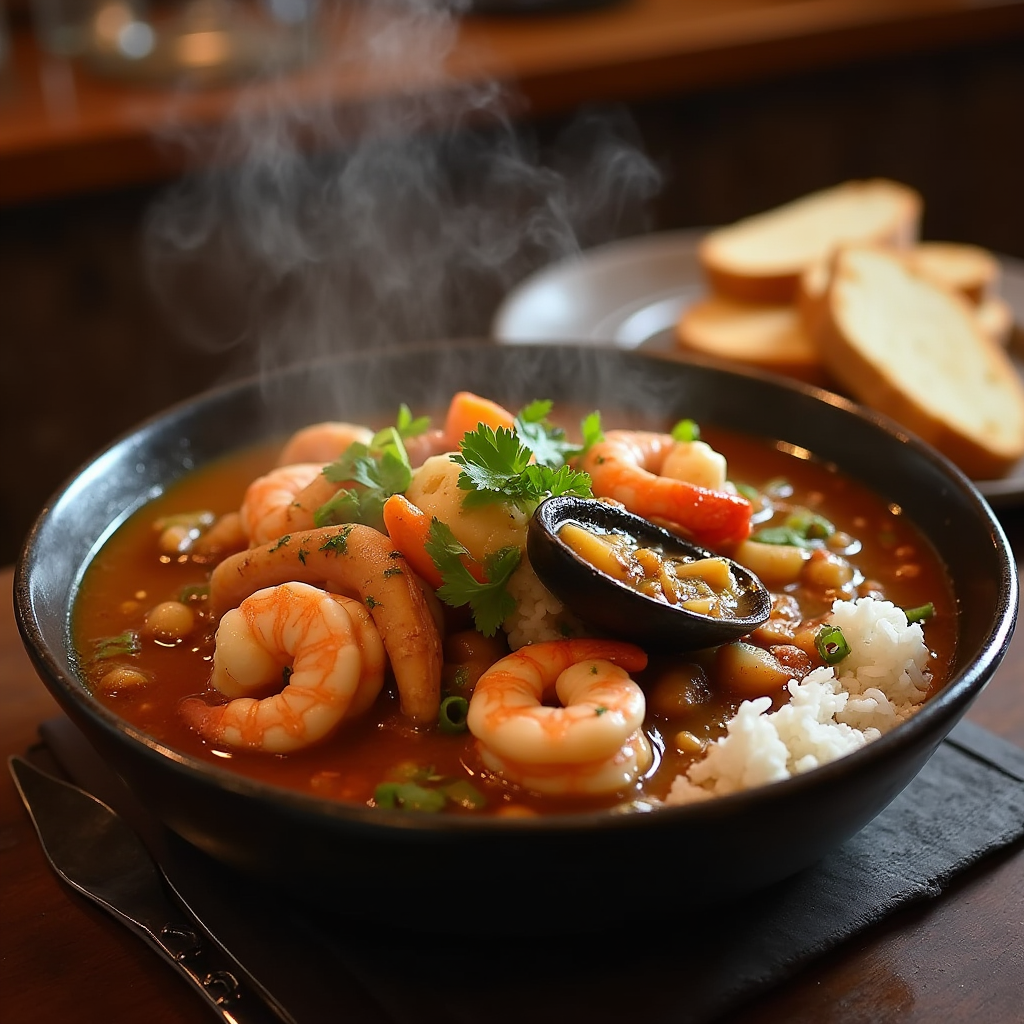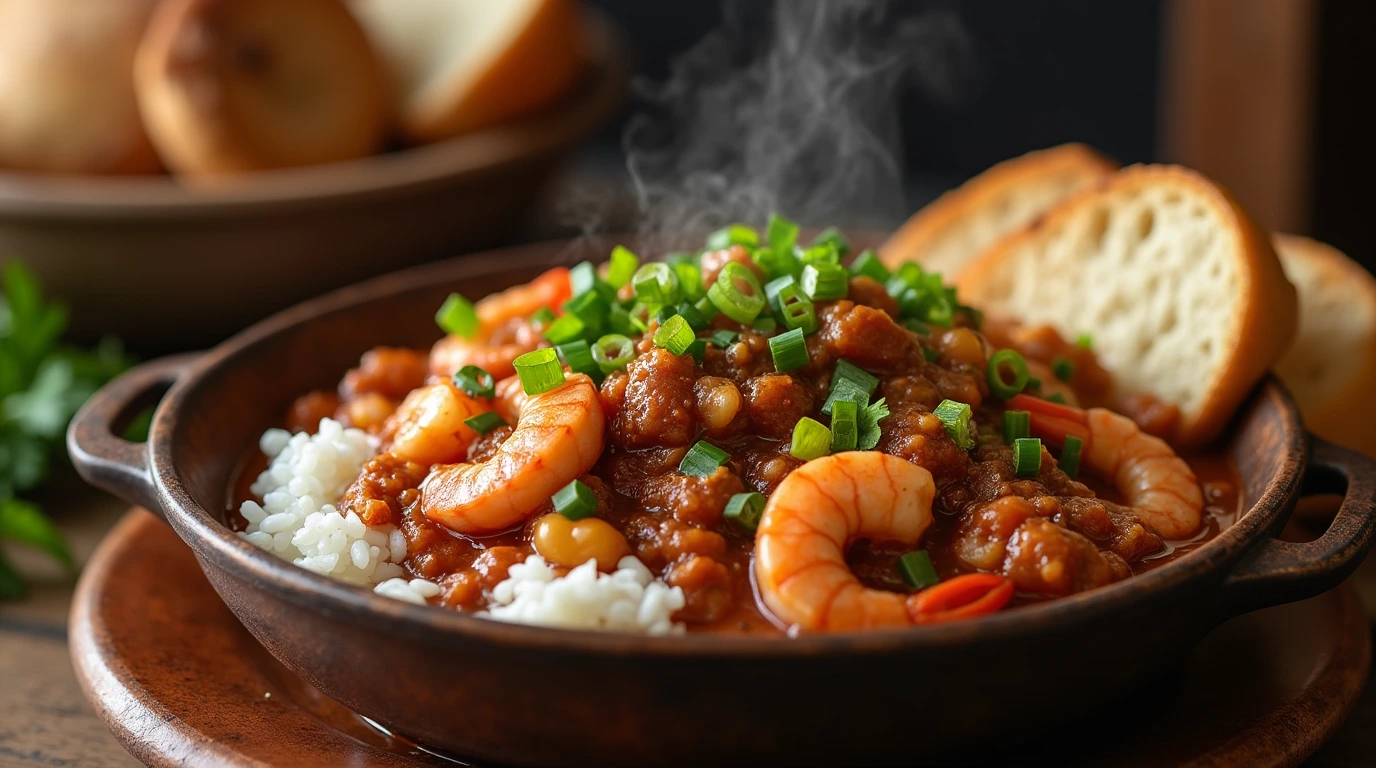Louisiana Seafood Gumbo Recipe – A Flavorful Cajun Classic
Introduction: A Taste of Tradition and Soul
There’s something magical about the aroma of Louisiana seafood gumbo filling your kitchen. The rich scent of spices mingling with the fresh, salty undertones of shrimp, crab, and fish takes you straight to the heart of Louisiana, where food isn’t just a necessity—it’s a way of life. Louisiana seafood gumbo is more than just a dish; it’s a celebration of culture, family, and tradition, a recipe passed down through generations.
For those who’ve had the pleasure of tasting this beloved Cajun dish, you know that it’s not just about the ingredients. It’s about the love and patience that go into every pot. Whether you’re making gumbo for a festive gathering or a quiet evening at home, this recipe will transport you straight to the bayou. So, grab your apron, and let’s dive into the delicious, soul-warming world of Louisiana seafood gumbo.
Table of Contents
What is Louisiana Seafood Gumbo?
If you’re unfamiliar with gumbo, let’s take a moment to introduce you to one of Louisiana’s most cherished dishes. At its core, gumbo is a flavorful stew or soup, traditionally served over rice. It’s been influenced by the diverse cultures of Louisiana, including French, African, Spanish, and Native American cooking traditions. But what makes seafood gumbo stand out is the fresh, local seafood it features.
The heart of gumbo lies in its base—the roux. This mixture of flour and fat is slowly cooked to a rich, deep brown color, serving as the foundation for all the layers of flavor that follow. For seafood gumbo, this savory base is complemented by the flavors of shrimp, crab, and other seafood varieties. It’s a dish that’s hearty, comforting, and incredibly satisfying.
What makes Louisiana seafood gumbo truly special is the way it brings people together. It’s the perfect dish for family gatherings, celebrations, or just a cozy meal at home.
Essential Ingredients for the Perfect Louisiana Seafood Gumbo
The beauty of Louisiana seafood gumbo lies in its simplicity and the quality of its ingredients. Below are the essential ingredients you’ll need to bring this dish to life:
- Seafood: The key to a great seafood gumbo is fresh, high-quality seafood. Shrimp, crab, and oysters are the most common choices, but you can also add fish or crawfish to suit your taste.
- Vegetables: The “Holy Trinity” of Cajun cooking is essential to gumbo. This refers to a mixture of onions, bell peppers, and celery, which form the aromatic base for the dish.
- Seasonings & Spices: Paprika, thyme, bay leaves, garlic, cayenne pepper, and black pepper are the standard seasonings in gumbo. Together, they create a flavor profile that’s warm, earthy, and slightly spicy.
- Roux: The roux is the thickening agent that gives gumbo its velvety texture. It’s made by cooking equal parts flour and fat (usually oil or butter) until it reaches a rich, brown color.
- Stock/Broth: A flavorful stock (typically fish or chicken stock) is used to create the broth that will simmer with the roux and vegetables, bringing the flavors together.
Let’s take a closer look at the key ingredients you’ll need:
Table: Ingredients for Louisiana Seafood Gumbo
| Ingredient | Quantity | Notes |
|---|---|---|
| Shrimp | 1 lb | Peeled and deveined |
| Crab Meat | 1 lb | Fresh or canned |
| Onion | 1 large | Chopped |
| Bell Pepper | 1 medium | Chopped |
| Celery | 2 stalks | Chopped |
| Roux (flour & fat) | 1/2 cup | Browned to a rich color |
| Garlic | 4 cloves | Minced |
| Bay Leaves | 2 leaves | Whole |
| Paprika | 1 tsp | For flavor |
Step-by-Step Instructions to Make Louisiana Seafood Gumbo
Making Louisiana seafood gumbo is an art that requires patience and attention to detail. Follow these simple steps to create a dish that will have your family asking for seconds.
Preparing the Roux: The Heart of the Gumbo
The roux is the foundation of any gumbo, and it’s essential to get it just right. Start by heating oil (or butter) in a large pot over medium heat. Gradually add flour, stirring constantly to prevent lumps. Continue cooking the mixture for about 15 to 20 minutes, or until it reaches a deep brown color. The roux should have a rich, nutty aroma—this is the flavor that will infuse your gumbo.
Tip: Patience is key. If the roux burns, it will ruin the gumbo, so stir constantly and watch closely.
Sautéing the Vegetables
Once your roux is ready, add the chopped onions, bell pepper, and celery to the pot. This combination, known as the “Holy Trinity,” is the backbone of many Cajun dishes. Sauté the vegetables for about 5 minutes, or until they’ve softened and become fragrant.
Building the Gumbo Base
Now that your roux and vegetables are ready, it’s time to bring everything together. Add minced garlic, bay leaves, paprika, thyme, cayenne pepper, and black pepper. Stir the mixture to coat the vegetables and bring out the full depth of the spices. Then, slowly add your stock—fish or chicken stock works best—stirring constantly to create a smooth broth.
Bring the mixture to a boil, then reduce the heat and let it simmer for about 30 minutes. This gives the flavors a chance to meld together and develop a rich, savory taste.
Incorporating the Seafood
It’s time to add the star of the dish: the seafood. Gently fold in your shrimp, crab, and any other seafood you’re using. Cook the seafood for about 5 to 7 minutes, just until the shrimp turn pink and the crab is heated through. Be careful not to overcook the seafood, as it can become tough.


Tips for the Best Louisiana Seafood Gumbo
To make sure your gumbo turns out just right, keep these tips in mind:
- Use Fresh, Local Seafood: The quality of your seafood will make a huge difference in the flavor of your gumbo. Whenever possible, buy fresh seafood from local markets or fishmongers.
- Slow Simmer: Don’t rush the cooking process. Let your gumbo simmer on low heat for at least 30 minutes to let the flavors meld. The longer it simmers, the better it tastes.
- Adjust the Seasoning: Gumbo is all about balancing flavors. Taste your gumbo as it cooks and adjust the seasoning as needed. Add more cayenne for heat or more thyme for a deeper flavor.
- Add Okra for Authenticity: If you want to make your gumbo even more authentic, consider adding okra, a classic ingredient in Louisiana gumbo. Okra thickens the broth and adds a unique texture.
Common Mistakes to Avoid When Making Seafood Gumbo
Even the best chefs can make mistakes in the kitchen, so here are some things to watch out for:
- Burning the Roux: This is one of the most common mistakes when making gumbo. If your roux burns, you’ll need to start over, as it will leave a bitter taste. Stir constantly and don’t rush the process.
- Overcooking the Seafood: Seafood cooks quickly, so don’t add it too early. Add your seafood last and cook it just until it’s done. Overcooked seafood can become rubbery and tough.
- Skipping the Resting Time: Gumbo always tastes better the next day. After cooking, let it rest for a few hours (or overnight) to allow the flavors to develop and deepen.
Serving Your Louisiana Seafood Gumbo
Louisiana seafood gumbo is best served hot and fresh. Follow these serving suggestions to elevate your dish:
- Traditional Sides: Serve your gumbo over steamed white rice to soak up all the delicious broth. Pair it with a side of crusty bread or cornbread for dipping.
- Garnishes: Fresh parsley, a squeeze of lemon, or a few dashes of hot sauce are all great additions to your gumbo. They add a burst of freshness and a little kick of flavor.
Frequently Asked Questions (FAQ) About Louisiana Seafood Gumbo
Q1: What is the difference between Cajun and Creole seafood gumbo?
Cajun gumbo typically has a darker roux and is spicier, while Creole gumbo often includes tomatoes and has a milder flavor. Both versions are delicious, but they have distinct flavor profiles.
Q2: Can I make Louisiana Seafood Gumbo ahead of time?
Absolutely! Gumbo actually tastes better the next day, once the flavors have had time to meld together. You can store leftovers in the fridge for up to 3 days.
Q3: What type of seafood is best for gumbo?
Shrimp, crab, and oysters are the most common types of seafood used in gumbo. You can also add fish, crawfish, or any other seafood you prefer.
Q4: Can I substitute the seafood in gumbo?
Yes! While traditional gumbo features shrimp and crab, you can experiment with different types of seafood. If you prefer a vegetarian version, try using mushrooms, okra, and other vegetables.
Conclusion: Embrace the Richness of Louisiana Seafood Gumbo
There’s no denying that Louisiana seafood gumbo is one of the most flavorful and comforting dishes you can make. It’s a dish that brings people together, whether you’re serving it at a family gathering or enjoying it alone on a quiet evening. With the right ingredients, a little patience, and a lot of love, you can create a bowl of gumbo that transports you straight to the heart of Louisiana.
So, what are you waiting for? Gather your ingredients, follow the steps, and start cooking your own Louisiana seafood gumbo today. Your taste buds—and your family—will thank you!
Did You Try Our Recipe?
There are no reviews yet. Be the first one to write one.

